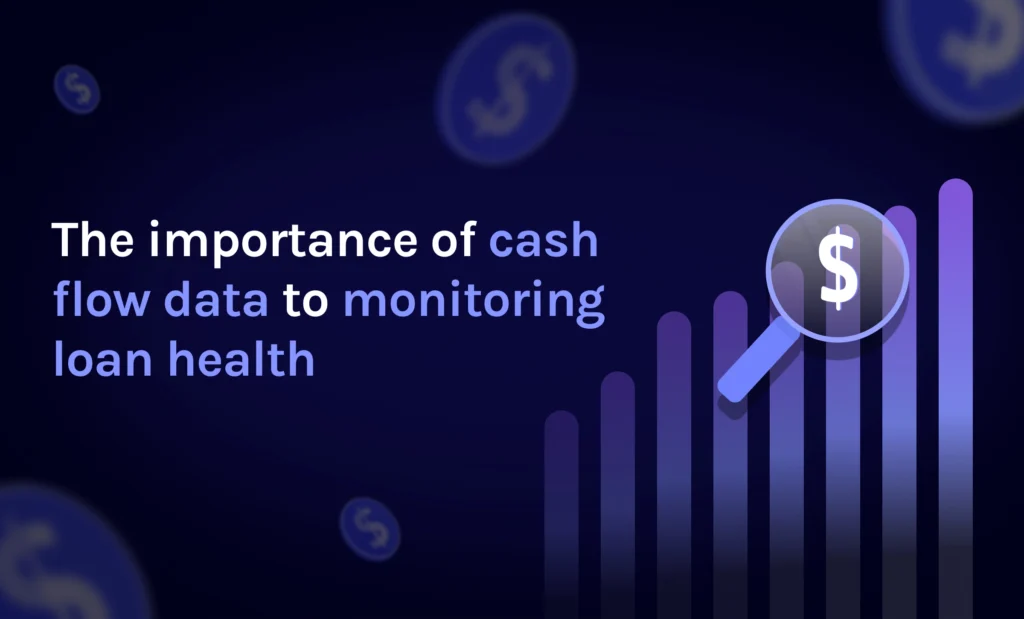This website uses cookies so that we can provide you with the best user experience possible. Cookie information is stored in your browser and performs functions such as recognising you when you return to our website and helping our team to understand which sections of the website you find most interesting and useful.
The importance of cash flow data to monitoring loan health

As new borrower types and income profiles challenge traditional criteria and processes for loan assessment, the lending world is implementing significant changes to keep up.
In today’s diverse economic environment and major housing market fluctuations, traditional metrics, such as credit scores, are no longer the definitive indicators of a borrower’s creditworthiness. This shift demands the adoption of more sophisticated risk assessment tools that remain effective throughout the life of a loan.
Employing cash flow data and analysis, lenders can take a more effective and proactive approach to monitoring loan health and adapting to borrowers’ changing financial profiles.
How lenders use cash flow analysis
Cash flow analysis focuses on the inflow and outflow of cash to paint a dynamic and comprehensive picture of an individual’s financial health.
By integrating cash flow data into their evaluation processes, lenders gain a more nuanced understanding of financial stability beyond traditional assessment methods’ abilities. This approach allows for a deeper insight into a borrower’s financial situation, offering a more precise tool for risk assessment than standard criteria like credit history alone can provide.
With a detailed analysis of income, expenses and financial trends found in cash flow data, lenders are equipped to make more informed and accurate lending decisions. This in-depth analysis is critical in navigating the complexities of modern financial landscapes.

Why cash flow data is indispensable for lenders
For proactive lenders, cash flow data has emerged as an indispensable tool, offering a nuanced view of a borrower’s financial landscape that goes above and beyond the boundaries of traditional metrics. The inclusivity of cash flow analysis effectively overcomes the constraints of conventional lending metrics, providing a wider lens through which to view financial health.
This broader perspective is especially beneficial for borrower segments like non-standard wage earners or individuals with multiple income sources. Equipped with timely and accurate insights, lenders can make decisions based on real-time risk profiles, gaining a deeper view of loan health and ensuring more adaptive and responsive lending practices.
Leveraging cash flow data for enhanced loan health monitoring
Effective cash flow monitoring is incredibly important to reducing the risk of loan defaults by offering early warning signs of potential financial challenges for a borrower. Real-time cash flow data enables lenders to unlock proactive risk management and loan servicing strategies. For instance, robust analyses of bank transactions provide a detailed understanding of a potential borrower’s cash flow, reducing the credit risk for lenders.
Cash flow data enables small business lenders to maintain insight beyond the application process, extending throughout the customer lifecycle. This is particularly important in understanding revenue growth, profitability, and cash balances for longer-term customers, as well as determining if the customer has obtained other sources of credit. With cash flow analytics for long-term monitoring, lenders can avoid miscalculations in debt capacity and better detect emerging risks in their portfolios.
This approach benefits lenders and borrowers alike. Cash flow analysis promotes a mutually beneficial relationship by decreasing risk and aiding borrowers in preserving their financial well-being, providing additional trust and transparency between lenders and borrowers.
With the rise of non-traditional borrowers, using cash flow data for loan oversight has become a critical strategy for lenders to manage and understand their increasingly diverse customer portfolios.
Providing detailed insights into borrowers’ financial health by analyzing cash flow data enables lenders to make more informed decisions – and the early warnings generated by cash flow analysis play a crucial role in risk mitigation, protecting lenders against potential defaults.
By adopting cash flow insights, lenders can tailor their financial solutions to meet individual borrower needs more efficiently, fostering a more resilient, transparent, and responsive lending process.
Book your demo to discover how Ocrolus empowers lenders to manage risk and make smarter decisions based on a complete picture of borrowers’ financial health.
Key takeaways:
- Cash flow analysis allows lenders to go beyond traditional credit scores, providing a dynamic view of a borrower’s financial situation for better loan health monitoring.
- By examining the inflow and outflow of money, lenders gain a deeper understanding of borrowers with non-standard incomes, improving decision-making.
- With cash flow analytics for long-term monitoring, lenders can avoid miscalculations in debt capacity and better detect emerging risks in their portfolios.





